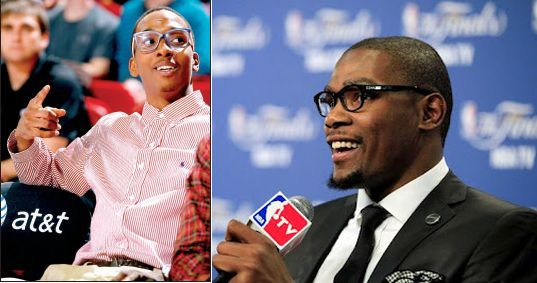
Before Monday night’s rout of some Division IV team named Lemoyne-Owen, Arkansas head coach Mike Anderson announced the state’s best basketball player had been suspended for breaking team rules.
Afterward, Anderson refused to tell the public why he sidelined his preseason All-American B.J. Young for two games.
If this had happened ten years ago, it would have been quite clear to onlookers Young was breaking unspecified rules of another sort.
On the bench during Arkansas’ 111-45 win over Lemoyne, Young wore a tucked-in pink polo shirt buttoned to the very top, accented by thick-rimmed baby blue glasses. Rewind a decade, and if Young had gone in public looking like this – like Fresh Prince’s Carlton Banks – his teammates would have razzed him to no end.
2002 was a different sartorial world, though. Allen Iverson was basketball’s most popular player, and his style – gold chains, baggy pants, backward caps – had been forming for decades. You’d seen it hit mass cultural conscience through the raphip-hop scene, yes, but before surfacing on MTV it had long brewed in streets of America’s largest cities and the giant prison complexes far away from them.
Today’s elite basketball player draws inspiration from a wider range of sources. Rappers and hip hop artists still influence how NBA players’ dress, but the difference is that guys like Kanye West and Pharrell Williams are creating their own style. Indeed, author Wesley Morris believes West “ushered in the chic of the black nerd. He cleared a safe space for narcissism and self-deconstruction; for singing rappers with names like Drake, J. Cole, and Tyler, The Creator; for the Roots to be Jimmy Fallon’s house band; for the threat in the music to move from the street to the psyche. Hip-hop had already begun to splinter into a land of a million mixtapes before West’s arrival. And with that shattering, black male style was transitioning away from Sean Combs’ “Puffy” era gilded age, with its plushness, flamboyance, glamour, and actionable danger.”
In today’s basketball culture, hardly any one raises a brow.
“In the same way that there are people who never thought they’d see a black American president, there are also people who never thought they’d see a black basketball star dressed like a nerd,” Wesley Morris wrote for Grantland. He added:
When David Stern imposed the league’s reductive dress code six years ago, all this role-playing, reinvention, and experimentation didn’t seem a likely outcome. We all feared Today’s Man. But the players — and the stylists — were being challenged to think creatively about dismantling Stern’s black-male stereotyping. The upside of all this intentionality is that these guys are trying stuff out to see what works. Which can be exciting. No sport has undergone such a radical shift of self-expression and self-understanding, wearing the clothes of both the boys it once mocked and the men it desires to be.
In the late 1980s through early 2000s, fashion among many elite African-Americans basketball players had much more definite boundaries. Whatever was in vogue – whether Air Jordans, Starter jackets, Karl Kani hoodies or FUBU jeans – that gear was cool for cool’s sake. These days, however, stuff can be cool for irony’s sake. As Morris puts it, “21st-century blackness has lost its rigid center, and irony permeates the cultural membrane.”
Geek chic attire, as rocked (pebbled?) by NBA stars Kevin Durant, Russell Westbrook and James Harden, had been seen in Oklahoma City for at least the last three years. With B.J. Young following suit, it’s clear this trend has spread to Oklahoma’s neighboring state.


